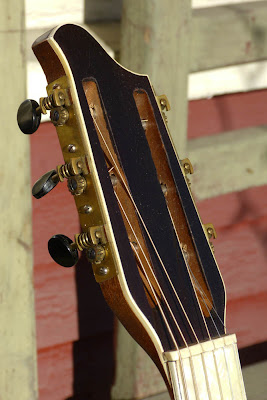c.1930 Stromberg-Voisinet Hawaiian-decal "Parlor" Guitar
If you've been following the blog, you're probably pretty familiar with this roughly 0-sized model of Kay-made guitar as I've worked on a good number of them. This one probably predates the "Kay" name for the company, when it was known as Stromberg-Voisinet. This model was apparently fairly popular since they turn up pretty regularly (in various minor version changes). It must have fit in that "lots of bling for the buck" range of the market as they're very attractive and also nice-sounding instruments.
Like most Chicago makes, though, they generally need a bunch of work to get back up to snuff again. I did the work on this one for a customer and that included a neck reset, new bridge, complete refret (in this case, I used the same type of vintage wire from a different 30s Kay fretboard), setup, and associated other work. It came out of surgery quite nice: good midrangey and sweet tone, nice string height over the body, and a pretty clean look.
One big thing going for this guitar is that it had zero cracks coming into the workshop and there was no brace work needed, so it was sturdy right up front.
This has an all-mahogany (solid) body with a poplar neck and pearloid-veneered maple fretboard. The (missing) original bridge would have likely been dyed maple. The 'hog used on these guitars is very pretty stuff and generally catches a gorgeous amount of sunlight in its grain.
If you look closely you can see how the fretboard extension has been "wedged" up like on an archtop guitar. This aligned it with the neck portion of the board after the neck reset. When I have to readjust a fretboard extension angle I also usually add a wide, thin "patch" to the underside of the extension area of the top. This stiffens that area up and helps to deal with the tension of strings in gauges of 50w-11 and above (50w-11 are on it right now).
I installed a wide ebony bridge with fun, Guild-ish back-edge darts to give it a similar look to what would have originally been on here. The pins are decent-quality plastic ones and the saddle is compensated and bone.
When original pin bridges are missing or damaged on these old ladder-braced guitars I often like to replace them with slightly wider and thicker bridges of good, durable materials (rosewood or ebony). This stabilizes tops that are lightly braced.
Pretty pearloid pickguard, huh? ...and of course, beautiful inlaid "marquetry" purfling and real celluloid binding.
Bound, pearloid-bedecked board. The original frets on this guitar had been entirely ground down flat and were useless. These "new" ones were "ported over" from a mid-30s KayKraft fretboard that was in my parts bin. They had full height and because of that, after installing, I was still able to remove a tiny amount of twist and warp in the neck via a fret level and dressing.
Cool, bound "Gumby" headstock with original bone nut. Dyed veneer on the front.
It sure is pretty!
Original brass-plate tuners work just fine.
If you look closely you can see a small amount of discoloration at the heel joint. I had to backfill some areas in the joint after resetting the neck to its proper back-angle.
The slotted headstock is (very-awesomely) only half-cut through.
Here's a picture from while it was getting repaired. Here I've removed all the old frets and started adding "new" ones from an old board.
Here I'm using nippers to pull the old frets out of the other board. Note the chip-out: I'm not bothering to cleanly do this on the other board because it's just scrap at this point.
In pearloid-fronted boards like this I never trust the tang of the frets to do all the work of holding them in place over time. These Kay-made guitars have a bad history (in my workshop, at least) of always needing these frets pulled out and glued back in because the pearloid curls or shrinks (or whatever) and the frets get loose and rock in the slots (not a good thing as it can cause buzzing).
You can see here that I'm wicking in some super glue before I pop the fret in and then knock it down flat and straight with my fret hammer. This gives it a very secure hold in the slot.

















Comments